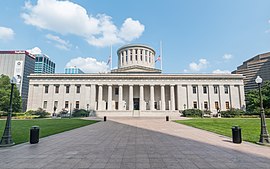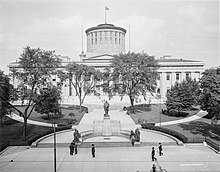
The Texas State Capitol is the capitol and seat of government of the American state of Texas. Located in downtown Austin, Texas, the structure houses the offices and chambers of the Texas Legislature and of the Governor of Texas. Designed in 1881 by architect Elijah E. Myers, it was constructed from 1882 to 1888 under the direction of civil engineer Reuben Lindsay Walker. A $75 million underground extension was completed in 1993. The building was added to the National Register of Historic Places in 1970 and recognized as a National Historic Landmark in 1986.

The Minnesota State Capitol is the seat of government for the U.S. state of Minnesota, in its capital city of Saint Paul. It houses the Minnesota Senate, Minnesota House of Representatives, the office of the Attorney General and the office of the Governor. The building also includes a chamber for the Minnesota Supreme Court, although court activities usually take place in the neighboring Minnesota Judicial Center.

The Nebraska State Capitol is the seat of government for the U.S. state of Nebraska and is located in downtown Lincoln. Designed by New York architect Bertram Grosvenor Goodhue in 1920, it was constructed of Indiana limestone from 1922 to 1932. The capitol houses the primary executive and judicial offices of Nebraska and is home to the Nebraska Legislature—the only unicameral state legislature in the United States.

The Wyoming State Capitol is located in the city of Cheyenne. Cheyenne is the seat of government for the U.S. state of Wyoming. Built between 1886 and 1890, the capitol is located in Cheyenne and contains the chambers of the Wyoming State Legislature as well as the office of the Governor of Wyoming. It was designated a U.S. National Historic Landmark in 1987. The Capitol underwent an extensive three-year renovation and reopened to the public on July 10, 2019.

The Florida State Capitol in Tallahassee, Florida, is an architecturally and historically significant building listed on the National Register of Historic Places. The Capitol is at the intersection of Apalachee Parkway and South Monroe Street in downtown Tallahassee, Florida.
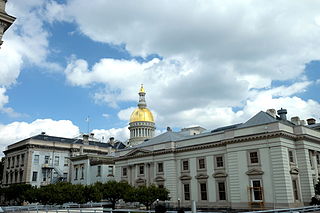
The New Jersey State House is the capitol building of the U.S. state of New Jersey and is the third-oldest state house in continuous legislative use in the United States. Located in Trenton, it was originally built in 1792 and is notable for its close proximity to the state border with Pennsylvania, which makes it the closest capitol building to a state border. The building accommodates both the New Jersey Legislature's Senate and General Assembly chambers, offices of the Governor, Lieutenant Governor, and various state government departments.

The Utah State Capitol is the house of government for the U.S. state of Utah. The building houses the chambers and offices of the Utah State Legislature, the offices of the Governor, Lieutenant Governor, Attorney General, the State Auditor and their staffs. The capitol is the main building of the Utah State Capitol Complex, which is located on Capitol Hill, overlooking downtown Salt Lake City.
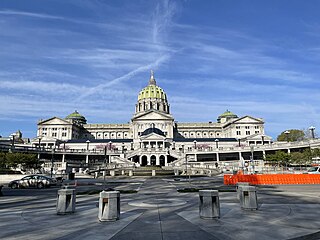
The Pennsylvania State Capitol is the seat of government for the U.S. state of Pennsylvania located in downtown Harrisburg which was designed by architect Joseph Miller Huston in 1902 and completed in 1906 in a Beaux-Arts style with decorative Renaissance themes throughout. The capitol houses the legislative chambers for the Pennsylvania General Assembly, made up of the House of Representatives and the Senate, and the Harrisburg chambers for the Supreme and Superior Courts of Pennsylvania, as well as the offices of the Governor and the Lieutenant Governor. It is also the main building of the Pennsylvania State Capitol Complex.

The Indiana Statehouse is the state capitol building of the U.S. state of Indiana. It houses the Indiana General Assembly, the office of the Governor of Indiana, the Indiana Supreme Court, and other state officials. The Statehouse is located in the capital city of Indianapolis at 200 West Washington Street. Built in 1888, it is the fifth building to house the state government.
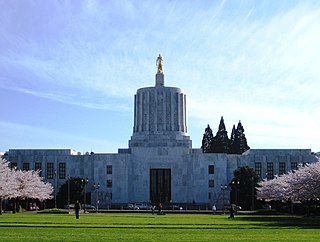
The Oregon State Capitol is the building housing the state legislature and the offices of the governor, secretary of state, and treasurer of the U.S. state of Oregon. It is located in the state capital, Salem. Constructed from 1936 to 1938 and expanded in 1977, the current building is the third to house the Oregon state government in Salem. The first two capitols in Salem were destroyed by fire, one in 1855 and the other in 1935.

The Mississippi State Capitol or the “New Capitol,” has been the seat of the state’s government since it succeeded the old statehouse in 1903. Located in Jackson, it was designated as a Mississippi Landmark in 1986, a National Historic Landmark in 2016 and added to the National Register of Historic Places in 1969.

The James A. Rhodes State Office Tower is a 41-story, 629-foot (192 m) state office building and skyscraper on Capitol Square in Downtown Columbus, Ohio. The Rhodes Tower is the tallest building in Columbus and the fifth tallest in Ohio. The tower is named for James A. Rhodes, the longest-serving Ohio governor, and features a statue of Rhodes outside the entrance. The building's interior includes a large open lobby with 22 elevators. Higher floors have offices for numerous state agencies. The tower's 40th floor contains an observation deck, open to the public.

The Michigan State Capitol is the building that houses the legislative branch of the government of the U.S. state of Michigan. It is in the portion of the state capital of Lansing which lies in Ingham County. The present structure, at the intersection of Capitol and Michigan Avenues, is a National Historic Landmark that houses the chambers and offices of the Michigan Legislature as well as the ceremonial offices of the Governor of Michigan and Lieutenant Governor. Historically, this is the third building to house the Michigan government.

The United States Capitol building features a central rotunda below the Capitol dome. Built between 1818 and 1824, the rotunda has been described as the Capitol's "symbolic and physical heart".

Columbus City Hall is the city hall of Columbus, Ohio, in the city's downtown Civic Center. It contains the offices of the city's mayor, auditor, and treasurer, and the offices and chambers of Columbus City Council.
Columbus, the capital city of Ohio, was founded on the east bank of the Scioto River in 1812. The city was founded as its capitol, beside the town of Franklinton, since incorporated into Columbus. The city's early history was gradual, as residents dealt with flooding and cholera epidemics, and the city had few direct connections to other cities. This led creation of a feeder canal, and later, freight and passenger railroads. The city became known for its industry and commercial businesses into the 20th century, though it experienced a lull in development in the late 20th century. In the 21st century, Columbus has been increasingly revitalized, led by parks projects, new developments, and efforts to beautify individual neighborhoods.

Capitol Square is a public square in Downtown Columbus, Ohio. The square includes the Ohio Statehouse, its 10-acre (4.0 ha) Capitol Grounds, as well as the buildings and features surrounding the square. The Capitol Grounds are surrounded on the north and west by Broad and High Streets, the main thoroughfares of the city since its founding, forming the city's 100 percent corner. The grounds are surrounded by 3rd Street on the east and State Street on the south. The oldest building on Capitol Square, the Ohio Statehouse, is the center of the state government, and in the rough geographic center of Capitol Square, Columbus, and Ohio.
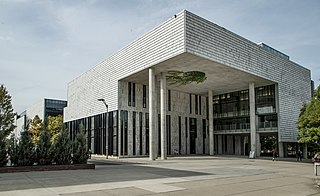
The architecture of Columbus, Ohio is represented by numerous notable architects' works, individually notable buildings, and a wide range of styles. Yost & Packard, the most prolific architects for much of the city's history, gave the city much of its eclectic and playful designs at a time when architecture tended to be busy and vibrant.
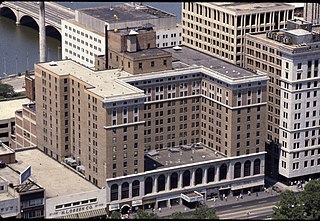
The Neil House was a historic hotel on High Street in Downtown Columbus, Ohio. The hotel operated on Capitol Square from 1842 to 1980.
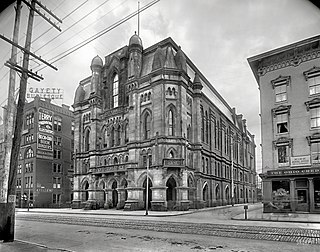
Columbus City Hall was the city hall for Columbus, Ohio, located on Capitol Square in the city's downtown. The building served the mayor and city council from its construction in 1872 until its demolition in 1921. The building was the founding site for the United Mine Workers of America in 1890. In 1928, the site became home to the Ohio Theatre, and the current Columbus City Hall opened nearby.
